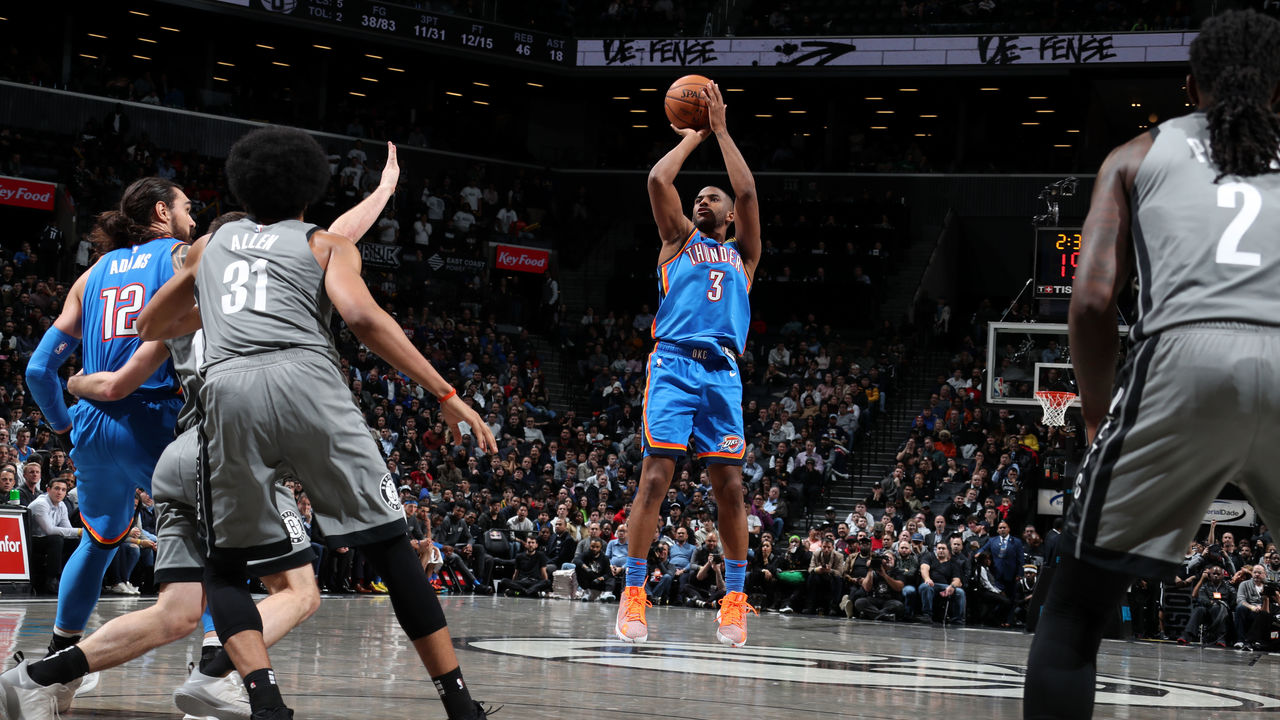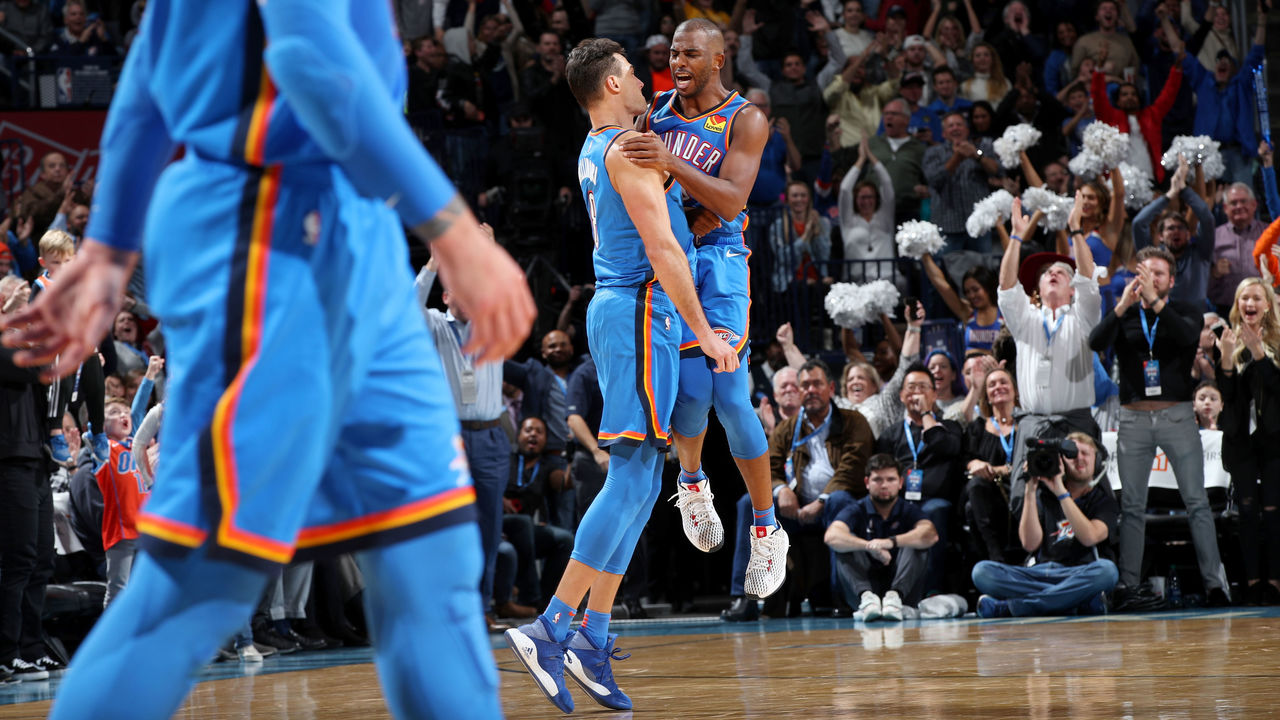Fight or flight: How do Thunder handle their surprising season?
Poor Isaiah Hartenstein never had a chance. With seven-and-a-half minutes remaining in Thursday's game between the Rockets and Thunder, Houston's young big man stepped up to trap Chris Paul as the star guard came off a screen. What followed was vintage Paul: ruthlessness, efficiency, bravado.
Paul bounced the ball through Hartenstein's legs with his left hand, picked it back up with his right, then dropped a flawless floater over P.J. Tucker to extend the Thunder's lead to 26 points. He capped that dazzling 10-second display by signaling to the crowd and the Thunder bench that his work for the night - spoiling Russell Westbrook's return to Oklahoma City and sticking it to his former team - was finished.
That's just rude, Mr. Paul. 😏 #nutmeg #havinghisway @CP3 | #ThunderUp pic.twitter.com/B3NEE9V9xU
— OKC THUNDER (@okcthunder) January 10, 2020
It was a fun, unexpected moment of brilliance in a season increasingly filled with such flashes for the Thunder, who entered the campaign as projected Western Conference cellar-dwellers after trading Westbrook and Paul George in the summer.
Instead, Thursday's convincing victory moved the Thunder to 22-16 - good for seventh in the West - with a win profile that now includes triumphs over the Rockets, Mavericks, Raptors, Clippers, Jazz, and 76ers. In a Western playoff race that has seen the bottom fall out, the Thunder are closer to second-place Denver (4 1/2 games back) than they are to ninth-place Memphis (six games). As presently constructed, Oklahoma City is a playoff team, full stop.
Paul is the steady veteran star steering the ship, but the Thunder have an intriguing blend of talent.
Versatile sophomore Shai Gilgeous-Alexander, acquired from the Clippers in the blockbuster that sent George to L.A., is in the running for Most Improved Player. Dennis Schroder is enjoying the most efficient season of his career, owns the Thunder's best on/off net rating, and might be the NBA's Sixth Man of the Year. The duo has combined to average 38.2 points per game on 47-35-81 shooting while possessing the length to guard bigger perimeter players on the other end.
Danilo Gallinari remains one of the game's elite offensive players as a stretch-four, and his liabilities are minimized on a team featuring a number of defensive problem-solvers. Steven Adams' screening, rebounding, and interior presence, meanwhile, make for a suitable anchor on both ends.
At the center of it all, of course, is Paul, who has rediscovered his Point God status after a down year in Houston last season. Paul's raw numbers - 16.7 points and a career-low 6.4 assists per game - don't exactly pop off the page. But watch enough Thunder games and dig deeper into the statistics, and the nine-time All-Star's impact on the West's most surprising team is clear.
When the game's on the line, Paul has the ball - and his opponents - on a string, posting a sparkling shooting line of 55-37-96 in clutch-time situations for one of the league's best clutch-time teams. And while the mid-range has mostly been where offense goes to die in the modern game, Paul is back to being a mid-range maestro, connecting on 52.4% of his attempts from 10-16 feet, the area from which he takes 30.9% of his shots.

Depth and shooting are issues for the Thunder, but their best five players have found some magic together, and head coach Billy Donovan isn't afraid to roll with that top five, no matter how unconventional the lineup.
Forty-six lineups across the league have logged at least 100 minutes together this season, and none has performed nearly as well as OKC's quintet of Paul, Gilgeous-Alexander, Schroder, Gallinari, and Adams. Together, they're more than 10 points per 100 possessions better than the next-best big-minute lineup.
In fact, of the 172 five-man lineups that have logged at least 100 minutes together over the last two seasons, the Thunder's best five still come out on top.
| Last 2 seasons | Mins. | ORtg | DRtg | Net |
|---|---|---|---|---|
| Paul-SGA-Schroder-Gallinari-Adams | 110 | 126.0 | 95.9 | +30.1 |
| Curry-Thompson-Iguodala-Durant-Green | 178 | 125.3 | 97.3 | +28.0 |
A three-point-guard lineup isn't exactly a novelty nowadays, but most teams employ such units in specialized situations, not as their go-to option the way the Thunder do. Then again, not many teams have the personnel to construct a 3-PG lineup as seamless as OKC's.
Any potential size concerns are mitigated by the collective IQ and defensive length of OKC's three guards, along with Adams' relentless rebounding. Opposing offenses can't just target Gallinari when the Thunder have the speed to help, recover, and force turnovers. Opposing defenses, meanwhile, have to worry about three ball-handlers and playmakers, and a fourth player in Gallo who can create his own offense.
"Whenever you can get into the teeth of the defense and penetrate, you're going to be forcing rotations, which generally leads to pretty good offense. Us having those three guys (on the court) certainly helps us," Donovan said before a December win in Toronto. "And even though (Gallinari) is a forward, he has a really high skill level to be able to do that as well. Getting into the teeth of the defense is critical for us, offensively.
"If we can get the ball ahead of the defense - generally when the defense is trying to catch up as the ball starts moving - that's when you're going to be able to generate (good) shots. When you get bogged down and you're not loosening the defense, and the defense is locked in, the floor is stationary. It becomes a lot easier (for the defense) to load up and help."

As you've probably assumed by now, there's a catch here.
A rebuilding team with impact veterans on the roster, the Thunder were expected to be one of the league's most aggressive sellers ahead of February's trade deadline, and that reportedly hasn't changed despite their surprising first half.
That's a shame. It's tough to abandon well-laid plans, but the Thunder also owe it to themselves to see what this team might be capable of.
Though the franchise is still descending from its years as a postseason mainstay, this specific Thunder team isn't a perennial contender losing steam at the end of the road. It's a fresh squad with a nice mix of youth and experience that has yet to be proven incapable when the lights shine brightest come springtime. Given Paul's form right now, it's not a stretch to say that, outside of superstars in Los Angeles and Milwaukee, he's capable of outplaying anyone over a two-week playoff series.
Extracting something of value from Gallinari's expiring contract makes sense, but the George and Westbrook trades helped OKC stockpile an unprecedented 15 first-round picks over the next six drafts. The Thunder are well-positioned for the future and might already possess the asset capital required to trade for a star should the opportunity present itself. Moreover, general manager Sam Presti has fared much better in negotiating transactions than he has in navigating recent drafts.
Paul, Adams, and Schroder are all under contract through next season (Paul also owns a $44.2-million player option for 2021-22). Why not ride out this encouraging wave while Gilgeous-Alexander continues to grow into stardom and see what this unique team can become? Even in the case of Gallo, Presti and the Thunder should be sure that any assets acquired in dealing him will be worth more to the long-term fortunes of the franchise than Gallo's presence would be to a potential playoff run this spring.
There is risk, of course. It's possible, perhaps likely, that Paul, who turns 35 in May, can't keep this up much longer, and players like Adams and Schroder could lose value if OKC comes crashing back to earth. In that scenario, delaying a sell-off because the Thunder became prisoners of the moment could derail their plans for the future.
But given the only evidence available, one could just as well argue this team is one right short-term move away from contention, with a long-term treasure chest already in place.
Presti is a pragmatic executive, and maintaining seller status seems like the safe bet for Oklahoma City. But this Thunder team's performance makes eschewing safety quite tempting. Perhaps it's time for Presti and Co. to navigate this unexpected territory with the same flair Paul displays running a pick-and-roll or a fast break.
Sometimes the safe play doesn't fit traditional, rigid definitions. Sometimes, when you're good enough, the safe play is nutmegging your defender and buying into your own greatness.